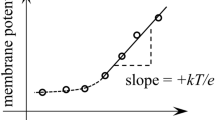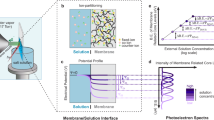Abstract
The physical concepts and problems associated with the understanding of ionic, electronic, and protonic transport in membrane structures are discussed. Ion transport is intimately associated with the existence of a transmembrane potential, and the contributions that ion concentration gradients, membrane surface charges, and surface redox reactions may give to this are described, together with the physical features required of ion channels and pores. An understanding of the coupling of electron transport processes to proton motive forces is a central task for modern bioenergetics, and some of the factors involved are discussed, as well as the physical mechanisms that control electron and proton transport processes in membrane structures. Other topics included are the dielectric properties of biological electrolytes, electronic induction, and dipole interactions in proteins, and proton transport in water, ice, and model systems.
Access this chapter
Tax calculation will be finalised at checkout
Purchases are for personal use only
Preview
Unable to display preview. Download preview PDF.
Similar content being viewed by others
References
W. Hasseibach and H. Oetliker, “Energetics and Electrogenicity of the Sarcoplasmic Reticulum Calcium Pump,” Ann. Rev. Physiol. 45, 325–339 (1983).
C. Tanford, “Mechanism of Free Energy Coupling in Active Transport,” Ann. Rev. Biochem. 52, 379–409 (1983).
L. M. Amzel and P. O. Pedersen, “Proton ATPases: Structure and Mechanism,” Ann. Rev. Biochem. 52, 801–824 (1983).
P. Mitchell, “Coupling of Phosphorylation to Electron and Hydrogen Transfer by a Chemi-osmotic Type of Mechanism,” Nature 191, 144–148 (1961).
P. Mitchell, “Chemiosmotic Coupling in Oxidative and Photosynthetic Phosphorylation,” Biol. Rev. 41, 445–502 (1966).
P. Mitchell, “Compartmentation and Communication in Living Systems. Ligand Conduction: A General Catalytic Principle in Chemical, Osmotic and Chemiosmotic Reaction Systems,” Eur. J. Biochem. 95, 1–20 (1979).
S. J. Ferguson and M. C. Sorgato, “Proton Electrochemical Gradients and Energy Transduction Processes,” Ann. Rev. Biochem. 51, 185–217 (1982).
R. J. P. Williams, “Possible Functions of Chains of Catalysts,” J. Theor. Biol. 1, 1–13 (1961).
R. J. P. Williams, “Proton-Driven Phosphorylation Reactions in Mitochondrial and Chloroplast Membranes,” FEBS Lett. 53, 123–125 (1975).
R. J. P. Williams, “The Multifarious Couplings of Energy Transduction,” Biochim. Biophys. Acta. 505, 1–44 (1978).
D. B. Kell, “On the Functional Proton Current Pathway of Electron Transport Phosphorylation. An Electrodic View,” Biochim. Biophys. Acta. 549, 55–99 (1979).
D. B. Kell, D. J. Clarke, and J. G. Morris, “On Proton-Coupled Information Transfer along the Surface of Biological Membranes and the Mode of Action of Certain Colicins,” FEMS Microbiol. Lett. 11, 1–11 (1981).
D. B. Kell and G. D. Hitchens, “Proton-Coupled Energy Transduction by Biological Membranes. Principles, Pathways and Praxis,” Faraday Discuss. Chem. Soc. 74, 377–388 (1982).
E. Elul, “Fixed Charge in the Cell Membrane,” J. Physiol. 189, 351–365 (1967).
O. Aono and S. Ohki, “Origin of Resting Potential of Axon Membrane,” J. Theor. Biol. 37, 273–282 (1972).
D. L. Gilbert and G. Ehrenstein, “Effect of Divalent Cations on Potassium Conductance of Squid Axons: Determination of Surface Charge,” Biophys. J. 9, 447–463 (1969).
E. Rojas and I. Atwater, “An Experimental Approach to Determine Membrane Charges in Squid Giant Axon,” J. Gen. Physiol. 51, 131s–145s (1968).
J. R. Segal, “Surface Charge of Giant Axons of Squid and Lobster,” Biophys. J. 8, 470–489 (1968).
S. Ohki, “Membrane Potential of Squid Axons: Comparison between the Goldman- Hodgkin-Katz Equation and the Diffusion/Surface Potential Equation,” in Charge and Field Effects in Biosystems (M. J. Allen and P. N. R. Usherwood, eds.), pp. 147–156, Abacus Press, Tunbridge Wells (1984).
A. Roos and W. F. Boran, “Intracellular pH,” Physiol. Rev. 61, 296–434 (1981).
J. Rothman and J. Lenard, “Membrane Asymmetry,” Science 195, 743–753 (1977).
J. Barber, “Influence of Surface Charges on Thylakoid Structure and Function,” Ann. Rev. Plant Physiol. 33, 261–295 (1982).
A. L. Hodgkin and B. Katz, “The Effect of Sodium Ions on the Electrical Activity of the Giant Axon of the Squid,” J. Physiol. 108, 37–77 (1949).
T. Teorell, “Transport Processes and Electrical Phenomena in Ionic Membranes,” Progr. Biophys. 3, 305–369 (1953).
S. Ohki, “Membrane Potential of Phospholipid Bilayer and Biological Membranes,” Progr. Surf. Membrane Sci. 10, 117–252 (1976).
D. C. Grahame, “The Electrical Double Layer and the Theory of Electrocapillarity,” Chem. Rev. 41, 441–501 (1947).
R. H. Brown, “Membrane Surface Charge: Discrete and Uniform Modelling,” Progr. Biophys. Molec. Biol. 28, 343–370 (1974).
J. O’M. Bockris and A. K. N. Reddy, Modern Electrochemistry, Chap. 7, Plenum Press, New York (1970).
R. A. Robinson and R. M. Stokes, Electrolyte Solutions, Butterworth, London (1970).
C. T. Yerkes and G. T. Babcock, “Surface Charge Asymmetry and a Specific Calcium Ions Effect in Chloroplast Photosystem II,” Biochim. Biophys. Acta 634, 19–29 (1981).
R. Pethig, P. R. C. Gascoyne, J. A. McLaughlin, and A. Szent-Györgyi, “Interaction of the 2,6-dimethoxysemiquinone and Ascorbyl Free Radicals with Ehrlich Ascites Cells: A Probe of Cell Surface Charge,” Proc. Natl. Acad. Sci. USA 81, 2088–2091 (1984).
M. A. Habib and J. O’M. Bockris, “Interpretation of Current-Potential Relationships across Biological Membranes,” J. Bioelectricity 1, 289–294 (1982).
R. Pethig, Dielectric and Electronic Properties of Biological Materials, Wiley, Chichester (1979).
R. Pethig, “Electronic Conduction in Biopolymers,” Electronic Conduction and Mechanoelectrical Transduction in Biological Materials (B. Lipinski, ed.), Marcel Dekker, New York (1982), pp. 1–98.
R. Pethig, “Biological Polymers,” in Noncrystalline Semiconductors (M. Pollak, ed.), CRC Press, Boca Raton (in press).
M. A. Habib and J. O’M. Bockris, Chapter 3, this volume.
J. B. Hasted, “Liquid Water: Dielectric Properties,” in Water: A Comprehensive Treatise (F. Franks, ed.), Vol. 1, pp. 255–309, Plenum, New York (1972).
S. Bone and R. Pethig, “Dielectric Studies of the Binding of Water to Lysozyme,” J. Mol. Biol. 157, 571–575 (1982).
T. E. Cross and R. Pethig, “Microwave Studies of the Interaction of DNA and Water in the Temperature Range 90-300 K,” Int. J. Quantum Chem: Quantum Biol Symp. 10, 143–152 (1983).
V. A. Parsegian, “Energy of an Ion Crossing a Low Dielectric Membrane: Solutions to Four Relevant Electrostatic Problems,” Nature (London) 221, 844–846 (1969).
D. T. Edmonds, “Membrane Ion Channels and Ionic Hydration Energies,” Proc. R. Soc. London Ser. B 211, 51–62 (1980).
P. C. Jordan, “Electrostatic Modeling of Ion Pores,” Biophys. J. 39, 157–164 (1982); 41, 189–195 (1983).
H. T. Witt, “Energy Conversion in the Functional Membrane of Photosynthesis. Analysis by Light Pulse and Electric Pulse Methods. The Central Role of the Electric Field,” Biochim. Biophys. Acta 505, 355–427 (1979).
W. N. Königs and J. Boonstra, “Anaerobic Electron Transfer and Active Transport in Bacteria,” Curr. Topics Membr. Transp. 9, 177–231 (1977).
M. Redi and J. J. Hopfield, “Theory of Thermal and Photoassisted Electron Tunneling,” J. Chem. Phys. 72, 6651–6660 (1980).
D. DeVault, “Quantum Mechanical Tunnelling in Biological Systems,” Quart. Rev. Biophys. 13, 387–564 (1980).
T. L. Poulos and J. Kraut, “A Hypothetical Model of the Cytochrome c Peroxidase. Cytochrome c Electron Transfer Complex,” J. Biol. Chem. 255, 10322–10330 (1980).
E. G. Petrov, “Role of Polypeptide Chain Structure in Donor-Acceptor Electron Transfer through Proteins,” Studia Biophysica 93, 237–240 (1983).
F. M. Richards, “Areas, Volume, Packing, and Protein Structure,” Ann. Rev. Biophys. Bioeng. 6, 151–176 (1977).
T. E. Cross and R. Pethig, “Microwave Hall Effect Measurements on Biopolymers,” Int. J. Quantum Chem.: Quantum Biol. Symp. 7, 389–395 (1980).
R. Pethig and A. Szent-Györgyi, “Electronic Properties of the Casein-Methylglyoxal Complex,” Proc. Natl. Acad. Sei. USA 74, 226–228 (1977)
S. Bone and R. Pethig, “Dielectric Properties of Protein-Methylglyoxal Adducts: Interfacial and Bulk Effects,” J. Chem. Soc., Faraday Trans. I 78, 1785–1794 (1982).
H. A. Scheraga, K. C. Chou, and G. Nemethy, “Interactions between the Fundamental Structures of Polypeptide Chains,” in Conformation in Biology (R. Srinivasan and R. H. Sarma, eds.), pp. 1–10, Adenine Press, New York (1982).
J. Warwicker and H. C. Watson, “Calculations of the Electrical Potential in the Active Site Cleft Due to α-Helix Dipoles,” J. Mol. Biol. 157, 671–679 (1982).
G. N. Ling, A Physical Theory of the Living State: The Association-Induction Hypothesis, Blaisdell, Waltham, Massachusets (1962).
B. E. Conway, J. O’M. Bockris, and H. Linton, “Proton Conductance and the Existence of the H3O Ion,” J. Chem. Phys. 24, 834–850 (1956).
M. Eigen and L. De Maeyer, “Self-dissociation and Protonic Charge Transport in Water and Ice,” Proc. R. Soc. London Ser. A 247, 505–533 (1958).
E. W. Knapp, K. Schulten, and Z. Schulten, “Proton Conduction in Linear Hydrogen- bonded Systems,” Chem. Phys. 46, 215–229 (1980).
P. R. C. Gascoyne, R. Pethig, and A. Szent-Györgyi, “Water Structure Dependent Charge Transport in Proteins,” Proc. Natl. Acad. Sei. USA 78, 261–265 (1981).
J. Behi, S. Bone, H. Morgan, and R. Pethig, “Effect of Deuterium-Hydrogen Exchange on the Electrical Conduction in Lysozyme,” Int. J. Quantum Chem: Quantum Biol. Symp. 9, 367–374 (1982).
F. Freund, “Proton Highlife and Midway Tunneling,” Trends Biochem. Sci. 6, 142–145 (1981).
W. Saenger, Ch. Betzel, B. Hingerty, and G. M. Brown, “Flip-Flop Hydrogen Bonding in a Partially Disordered System,” Nature (London) 296, 581–583 (1982).
S. Bone and R. Pethig, “Cyclodextrins as Model Systems for the Study of Proton Transport,” Int. J. Quantum Chem: Quantum Biol. Symp. 10, 133–141 (1983).
J. Behi, S. Bone, H. Morgan, and R. Pethig, “Protonic Charge Transport Studies in Cyclodextrins,” in Charge and Field Effects in Biosystems (M. J. Allen and P. N. R. Usherwood, eds.), pp. 139–146, Abacus Press, Tunbridge Wells (1984).
A. Szent-Györgyi, Introduction to a Submolecular Biology, pp. 135, Academic Press, New York (1960).
Author information
Authors and Affiliations
Editor information
Editors and Affiliations
Rights and permissions
Copyright information
© 1986 Plenum Press, New York
About this chapter
Cite this chapter
Pethig, R. (1986). Ion, Electron, and Proton Transport in Membranes: A Review of the Physical Processes Involved. In: Gutmann, F., Keyzer, H. (eds) Modern Bioelectrochemistry. Springer, Boston, MA. https://doi.org/10.1007/978-1-4613-2105-7_7
Download citation
DOI: https://doi.org/10.1007/978-1-4613-2105-7_7
Publisher Name: Springer, Boston, MA
Print ISBN: 978-1-4612-9246-3
Online ISBN: 978-1-4613-2105-7
eBook Packages: Springer Book Archive




